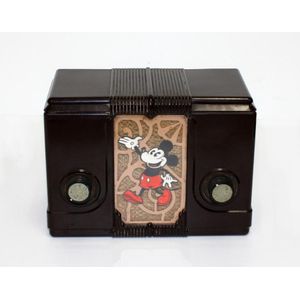Vitascope Sunrise Ship Clock
You must be a subscriber, and be logged in to view price and dealer details.
Subscribe Now to view actual auction price for this item
When you subscribe, you have the option of setting the currency in which to display prices to $Au, $US, $NZ or Stg.
- Chapter Ring - A separate metal plate on the face of a clock, on which the numerals for the hours and sometimes parts of the hours, are displayed, usually wheel shaped and sitting on top of the dial plate. The chapter ring is often a feature of the clock and can be silvered or enamelled to stand as a contrast to its background. The hours are usually shown in Roman numerals, although in the late 19th and earlt 20th century, Arabic numerals became fashionable.
- Bakelite - Bakelite was the first completely synthetic man-made substance. Bakelite was invented in 1909 by an independent New York chemist Leo H. Baekeland. It was called the "material of a thousand uses" and used to make everything from car parts to jewellery.
Although nearly all plastic from this period is known as ?Bakelite', it is important to remember that this is an umbrella term that covers many different early plastics such as Lucite and cellulose acetate, and includes Bakelite.
We often think of the colour of Bakelite items as dark brown, but it was manufactured in various colours including yellow, butterscotch, red, green and brown.
Bakelite could also be transparent, or marbleised by mixing two colours. Plastics were cheap to produce and could be moulded or carved in a huge variety of ways.
Bakelite is most commonly associated with radio cases of the 1930s, telephones and kitchen utensils, but it was also used extensively in jewellery manufacture.
Early designs from the 1920s were plainer and simpler than later examples. Geometric and floral patterns typical of Art Deco styling were popular.
During its heyday in the 1930s, Bakelite jewellery was stocked by the most prestigious stores, such as Saks, Harrods and Macy?s, who dedicated a shop window display to it in 1935.
Coco Chanel featured Bakelite items in her accessories collection and the material was praised frequently in Vogue magazine.
Manufacture of some consumer Items were suspended in 1942 in order to concentrate manufacturing on the war effort.
Small items made of Bakelite are now valuable collectables. Andy Warhol was an avid collector, and when he died in 1987, his pieces sold for record prices at Sotheby's.
This item has been included into following indexes:
Visually similar items

Art Deco Vitascope electric clock in bakelite case, rocking ship and colour changing ship, in working order, 32 cm high

A brown Bakelite 1930s 'Kadette' Jewel radio, made by International Radio Corp, Michigan, USA in excellent condition (untested). 19 x 10 cm

Minox B subminiature camera (1950-1971) in original leather case with pocket tripod, tripod head, fl ashgun, and owners manual. VG condition. (4 items)

Chinese decorated ceramic pillow phoenix and peony decoration on green glazed cartouche, length 34 cm
